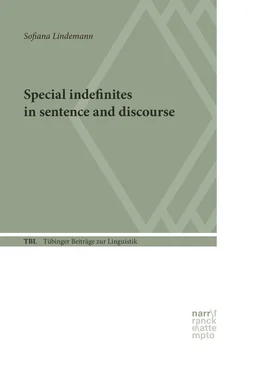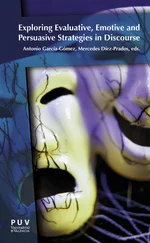Despite the fact that most of the above accounts focus on pronoun resolution (i.e. on the factors that license the use of a pronoun), I summarize those parts of their accounts, which deal with the import of indefinite noun phrases in structuring the following discourse. By the end of Chapter 2, I will propose two textual characteristics to measure the discourse structuring potential of indefinite noun phrases, namely (i) referential persistence, and (ii) topic shift potential. These factors will be used in the story-continuation investigations presented in the following three Chapters to test the discourse structuring potential of indefinite this in English, German indefinite so’n and Romanian pe .
In Chapter 3 I argue for an analysis of indefinite this in English as indicating the speaker’s referential intention to introduce a discourse prominent referent in the following text. First, in line with other findings (Prince 1981, Ionin 2006), I confirm the preference of indefinite this for particular referential readings. Second, the experimental results reported in this Chapter indicate that indefinite this functions as a discourse-structuring device. This function is reflected by the high referential persistence and by the topic shift potential of the referents marked in this way compared to their simple indefinite counterparts.
In Chapter 4 I investigate the behaviour of indefinite noun phrases headed by the indefinite determiner so’n . I show that so’n indefinites display a strong preference for referential readings, as rigid reference and epistemic specificity. This theoretical consideration receives further support from a web-based sentence interpretation task (Experiment 1), which shows that indefinite noun phrases headed by so’n tend to presuppose the existence of their associated referents in contexts that contain intensional operators and negation. Furthermore, indefinites headed by so’n introduce referents with particular discourse-pragmatic properties that become visible in contexts that do not contain operators at sentence level. In light of the findings of a sentence-continuation study (Experiment 2), I conclude that referents headed by so’n show effects upon the subsequent discourse similar to English indefinite this. Such referents are referentially highly continuous and more prone to shift the topic in a subsequent matrix clause.
Chapter 5 is centred on the distribution of pe -marking with indefinite noun phrases as an instance of Differential Object Marking (DOM) in Romanian. I show that pe -marking with indefinite noun phrases cannot be thoroughly accounted for, unless the broader discourse contexts in which such noun phrases are used is investigated. More precisely, contrary to previous approaches on DOM in Romanian (e.g. Dobrovie-Sorin 1994), I argue that (referential, scopal or epistemic) specificity is not sufficient to account for the distribution of the pe -marker in the domain of indefinite noun phrases and that pe -marked direct objects are also sensitive to the discourse context they appear in, changing the discourse properties of their referents. Based on the findings of an off-line story-continuation experiment, I show that pe -marked referents are devices for structuring the discourse, being interpreted by hearers as signals of high referential continuity. At the same time, pe -marked referents are more prone to shift the topic of the discourse. These findings receive further support from the analysis of definite unmodified noun phrases in direct object position that are characterized along the same lines, as discourse structuring devices.
Chapter 6 reviews the theoretical observations and the experimental evidence described in this book, which pointed out that different types of indefinite noun phrases give structure to the subsequent discourse in different ways. First, I will argue that the indefinite noun phrases discussed here achieve stability of reference (Farkas and Brasoveanu 2010) via prominence at the discourse level in terms of discourse structuring potential. Discourse prominence prevents these noun phrases to scope under certain operators. Thus, the indefinite noun phrases show a preference for particular referential interpretations because they are discourse prominent, and not vice versa. Second, I will discuss possible reasons for why languages use different devices to mark referents that will play a preferential role within a discourse. This proposal will build on several investigations on the grammaticalization path of the indefinite article cross-linguistically (Heine 1997, Givón 1981, Stark 2002).
The final Chapter sums up the main conclusions and discusses discourse theories against the findings brought to light in the more empirical Chapters. It is argued that any approach concerned with the status of a referent in the discourse has to distinguish between (at least) two properties of this referent, namely its (local) accessibility or prominence status and its discourse structuring potential. This Chapter also discusses some loose ends that suggest directions for further work.
This book is concerned with the use of a particular class of indefinite noun phrases in English, German and Romanian. In a plain context, speakers of the aforementioned languages could use, seemingly interchangeably, two types of indefinite noun phrases to refer to the same referent. In each of the three languages, one indefinite noun phrase form is headed by a special marker (i.e. indefinite this in English , so’n in German and pe -marking in Romanian), whereas the other form remains unmarked (i.e. it is headed by the simple indefinite determiner a/an ). While the propositional contribution of the two types of indefinite noun phrases seems to be the same, the two types of indefinite expressions differ with respect to their contribution at the discourse level in terms of the expectations they give rise to. A question that arises at this point is, on what grounds do speakers choose one type of referring expression over the other, so that their hearers can successfully identify the referent in question and generate expectations with respect to the subsequent discourse?
The three markers central to the present analysis, namely English indefinite this , German indefinite so’n and pe -marking in Romanian are used to introduce new referents in the discourse. Moreover, their sentence semantic contribution can be partly explained by appealing to their particular referential properties. In Chapters 3-5, I will discuss in turn the referential behaviour of each of the three types of indefinite noun phrases in sentences containing operators and in plain and transparent sentences and show that while they display an affinity for referential readings, this correlation is imperfect. In other words, while all three types of indefinite noun phrases tend to bear specific readings (compared to their simple indefinite counterparts), we still find sentences in which the indefinite noun phrases bare non-specific readings. Thus, the use of these indefinite noun phrases cannot be (solely) accounted for in terms of their sentence-level contribution and it seems that they impact larger discourse units. An analysis of the noun phrases headed by English indefinite this , German so’n and pe -marking in Romanian in terms of their discourse contribution may seem straightforward, but it simultaneously raises several questions, which I aim to answer in the remainder of this Chapter. First, it is important to note that the centrepieces of previous studies have been, with some exceptions, definite noun phrases, while the analysis of indefinite noun phrases has been often left unaddressed. The latter are either considered not to be referential expressions at all, or not to contribute in a significant way to the overall discourse structure. Thus, the first question that arises is, what the discourse contribution of indefinite noun phrases in general is and how it can be tested? More specifically, what are the textual characteristics that indicate their function at the discourse level? Second, most accounts investigating the contribution of different types of referring expressions limit their analyse to short discourse segments, consisting of two adjacent sentences. Another question that arises is, whether the impact of indefinite noun phrases can be observed within larger discours units, consisting of more than two adjacent matrix sentences? And finally, a more general question is, whether the observed effects can be traced back to accessibility or prominence alone, or whether we need to identify other mechanisms to account for the observed effects?
Читать дальше












